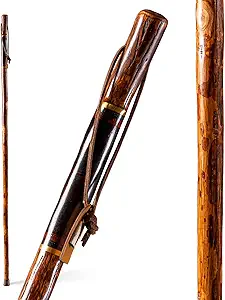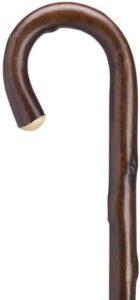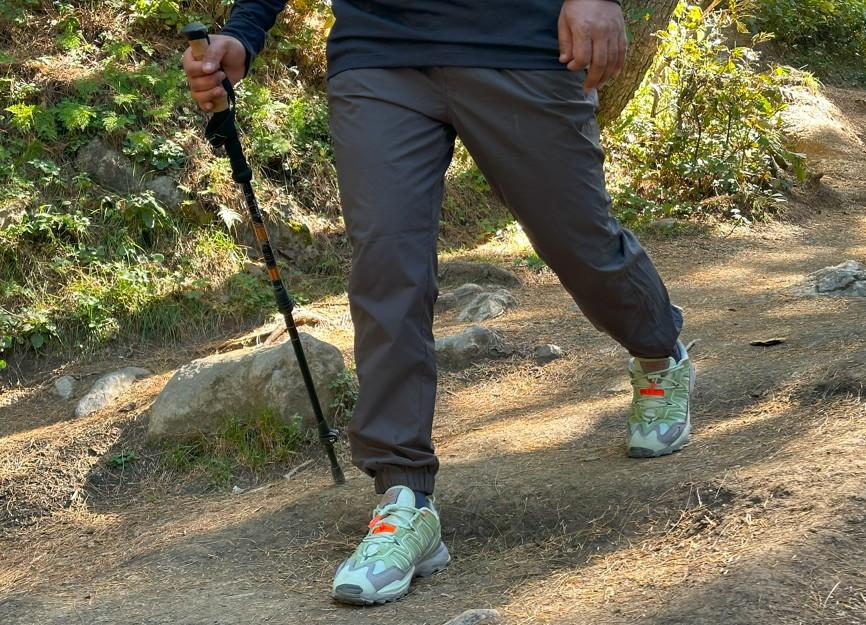The hiking stick is the companion of the trail. It offers more than just support—it becomes a reliable companion on tough terrains, a symbol of adventure, and a tool for stability. To get the best out of a stick, it is crucial to use the best wood in the stick. Choosing the right wood is the key to a perfect adventure with a stick.
While buying a stick, factors like durability, flexibility, aesthetics, weight, and style make all the difference.
Related: Best Budget Trekking Poles
This guide will explain the major wood types for a hiking stick, their benefits, and the ways to maintain them. If you are an avid hiker and you intend to buy your stick, this article will help you understand your needs and the right wood for different types of hikes.
Why Choose Wood for Your Hiking Stick?
Before delving deep into the discussion of the types of woods, let’s first understand the question of why we need a wooden hiking stick.
Wood is a sustainable, lightweight, and timeless material. Unlike metals or carbon fiber, wood offers superior shock absorption and blends harmoniously with natural surroundings.

The rustic appeal of wood adds to the natural look and seamlessly blends in with the environment. These qualities make the wood a favorite choice of traditionalists.
Related: One or Two Trekking Poles
As a whole, wood remains eco-friendly and versatile and adds to personal craftsmanship.
Top Woods for Hiking Sticks
Since nature connects with the soul, walking sticks made of natural wood appeal to the hikers more compared to synthetic material. Let’s know some types of wood:
Ash Wood
The ideal stick that serves all kinds of terrains and trails is made of ash wood. It sustains all kinds of weather and is resilient to shocks and high pressure. Additionally, it is lightweight, flexible, and strong, which holds pressure with grace. All these balanced properties make it a reliable and classic choice for the hikers.
Hickory
Another extremely strong and durable option to consider is that of hickory wood. It offers excellent support in heavy-duty trekking. Like any other natural stick, hickory also absorbs shocks, but it supports more weight and ensures longevity additionally.

However, due to the density of Hickory, it puts on more weight compared to its counterparts.
Maple
For excellent comfort and ergonomic style, I suggest maple wood sticks. It offers light-to-medium lightweight designs and a sturdy structure to hold maximum weight. The sturdy structure also gives a reliable and comfortable grip for hands on different trails. With all these qualities, maple wood suits general use in hikes.
Birch
Birches are the most aesthetic plants, which poets have used in their poems. The lightweight shape of their wood and docile nature make them an ideal fit for making various objects like hiking sticks. This wood is comparatively flexible, and it suits moderate usages where we don’t apply heavy weight. Considering its properties, birch is used as a DIY material, sometimes for making one’s own sticks.
Oak
Another great option for durable and strong sticks is that of oak. Its dense and hard structure works perfectly well is rugged terrains and with heavy weights. Although it is heavier than ash and maple, the sticks made with this wood are highly durable and have the capacity to bear loads.
Chestnut
Chestnut wood is one of the most famous woods in Europe. The walking sticks of chestnut are robust, attractive, and stylish. This wood is one of the best choices.

First introduced by Romans, it can be peeled back and made into incredibly stylish hiking sticks.
Cherry
Cherry wood is not stiff and hard. It may crack under a heavy load, but it compensates for this weakness by offering perfect style. It offers smooth finishing and attractive style to the hikers. I will suggest cherry wood for mild and moderate hikes. For rough terrains, it cannot be resilient owing to its soft and tender structure.
Teak
Teak is an amazing wood that offers one of the top-notch qualities of water resistance. Additionally, it is highly durable, strong, and ideal for rough and rigid terrains. Considering its water resistance, this wood is an ideal fit for the hikes in wet climates. The only problem is its weight, which makes hikers reconsider it as a viable option. Its price also increases with time, which makes it even more difficult to consider.
Best Hiking Stick Wood Features
A perfect hiking stick is lightweight, resilient, tough, and stylish. Let’s explain some of these aspects below:
- Durability: Sticks that offer great resilience and durability are better for hiking.
- Lightweight: During hikes, it is important to understand that weight is a crucial aspect. Lesser weight of the stick is always preferable to the hikers compared to heavyweight sticks.
- Flexibility: in rough terrains, rigid and inflexible sticks cause fatigue and back pain. Flexible sticks offer a good margin for shock absorption.
- Grip: The angle of the wrists and stick must be understood. If it misbalances, the whole arm starts to panic. Additionally, gripping the stick also helps the hiker to keep the surface dry and avoid slips.
- Workability: If you can make crafts on wood, prefer them over the ones that do not offer this quality. These woods are more workable comparatively.
How to Choose the Best Wood for Your Hiking Stick
Choosing the hiking wood is a meticulous job. It is important to understand your trail first in order to understand the kind of wood you are expecting.
For example, oak and hickory work best with rough and rugged terrains while ash wood and chestnut work great in casual hikes. While people look for durability, style is also a great aspect to consider.
Additionally, balance for shock absorption and stiffness for heavy loads are also considerable qualities to look for in a wood for a hiking stick. Finally, the hikers who have an aesthetic appeal can look for options like Cherry and Cedar. These options provide style and personal flair.
Comparison Table
| Wood Type | Weight | Durability | Flexibility | Ideal Use |
|---|---|---|---|---|
| Ash | Light | High | High | All-around hiking |
| Hickory | Medium | Very High | Medium | Rugged terrain, heavy loads |
| Maple | Medium | High | Medium | General hiking, good grip |
| Birch | Light | Moderate | High | Light hikes, DIY crafting |
| Oak | Heavy | Very High | Low | Mountainous, rocky hikes |
| Cherry | Light | Low | Moderate | Aesthetic hikes, casual walks |
| Teak | Heavy | Very High | Medium | Wet/humid climates |
How to Maintain a Wooden Hiking Stick
The hiking woods should be clean and steady. Apply beeswax; some oils are there. Theses aspects make a hiking stick to the plan.
Double oil during wet month seasons to fight humidity; in winter, guard from prolonged cold to avoid drying out. Repair slight damage as it occurs and switch care routines by the seasons.
Routine maintenance provides longevity, and your stick will be able to withstand heavy use. By prioritizing these steps, your hiking stick will be a reliable, long-lasting companion on all of your trail adventures.
Conclusion
Hiking is a healthy habit. Among the gear, a hiker needs to look for the durability of the material and the wedges, which help in arranging the design in a better way. The best wood for a hike depends on an individual’s needs. If you are planning to hike in rough terrain, you may need a durable and strong structure of wood. If the hike is through plains and meadows, your hiking needs may vary. It is important to educate the hiker to understand the trail and the woods. Different wood offers different physical and aesthetic compass.
FAQs
What wood makes the best hiking sticks?
Woods like ash, maple, and hickory are strong and resilient enough to make some wonderful hiking sticks. These woods are highly durable, flexible, and offer ergonomic comfort to the user.
How thick should a hiking stick be?
The thickness of a stick is directly proportional to its strength. Ideally, 1–1.5 meters is a perfect thickness for maintaining the durability of the hiking sticks.
Which type of walking stick is best?
The best hiking stick is the one that is best with the terrains. Ash, oak, and cedar offer versatility, durability, and casual climbing, respectively. Make sure to align the wood for the stick with the terrain you are going to wear.
Which is the strongest wood for a walking stick?
Hickory is the strongest wood so far. It offers great resilience and durability due to its compact style and dense structure of molecules.
Read More:
